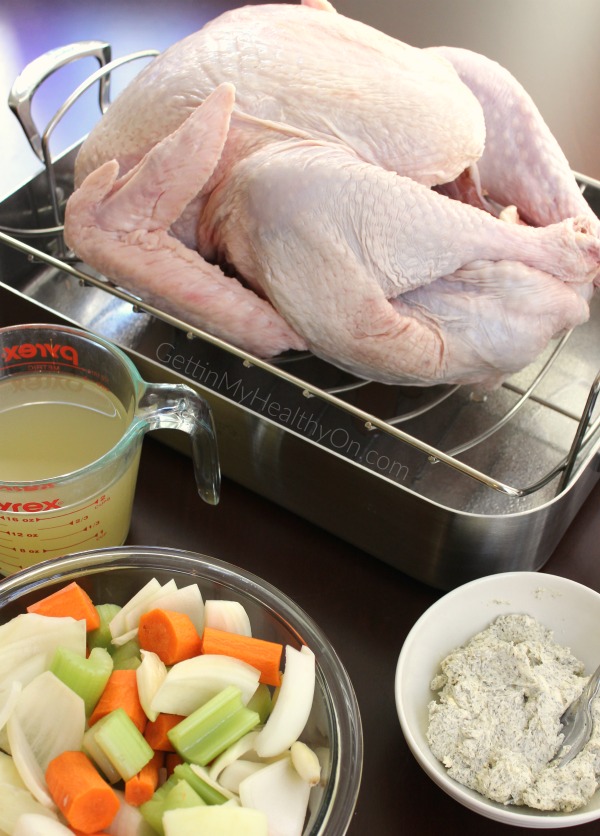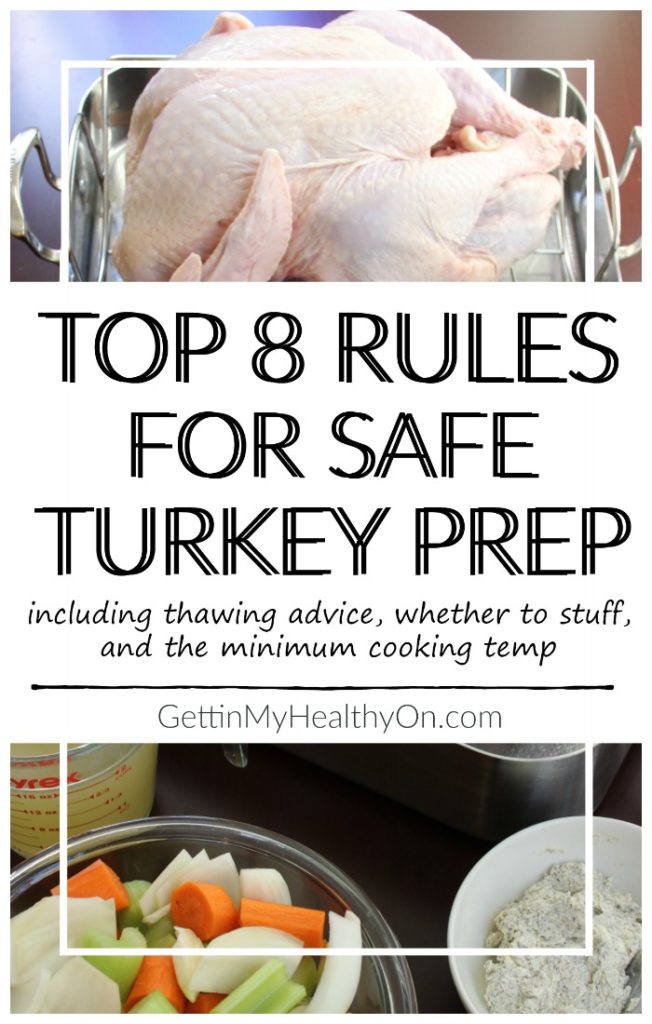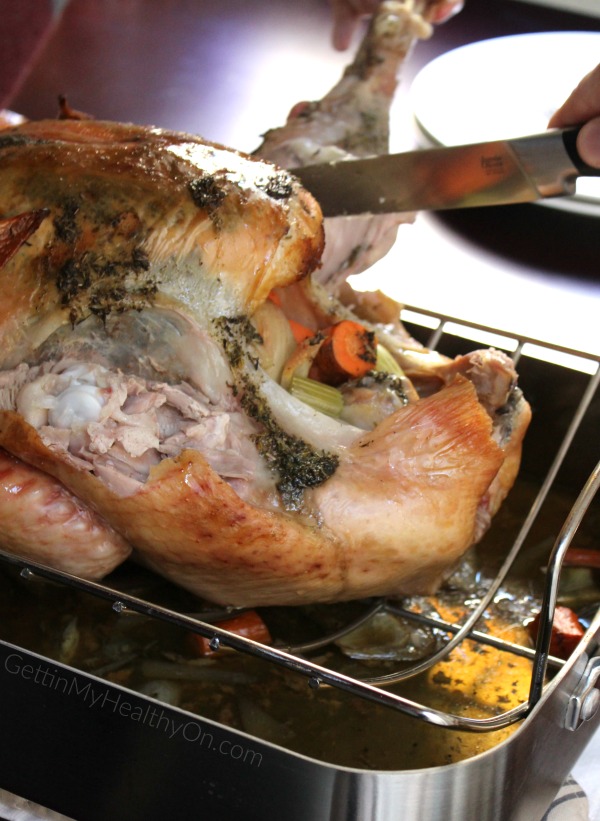Can you believe Thanksgiving is next week?! Slowly but surely, our plans are coming together for the food-centric holiday. Unlike recent years, I most likely will not be making my go-to Herb Roasted Turkey. Instead, I’ll be enjoying the fruits of our families’ labor and contributing other Thanksgiving food, like side dishes.
Just in case you plan to cook a turkey this year (or will be playing support for someone who is), there are certain safety rules you should remember. While your focus might be on making a delicious Thanksgiving bird or tasty side dishes, the most important aspect of the meal is making sure you don’t get everyone sick.

Salmonella is a real threat around Thanksgiving, because there are so many misconceptions about proper turkey handling and preparation (or people just overlook a lot of things). While some cooks seem to have a system and already know what’s up, I follow tried-and-true rules about turkey safety so I don’t second-guess myself.
Most of these tips relate to turkey freshness and turkey doneness, both of which can be confusing due to so many opinions out there. When it comes to turkey safety, I only listen to national organizations backed by scientific research. In other words, all of my advice in this post comes from:
- The U.S. Food and Drug Administration (FDA)
- The U.S. Department of Agriculture (USDA)
- The U.S. Department of Health & Human Services (HHS)
But don’t assume I know what I’m talking about; check out the linked sources after each rule!

1. If buying a fresh (un-frozen) turkey, get it within 2 days of cooking.
Frozen turkeys can keep for up to a year and still be good. If you buy a fresh turkey, though, the USDA recommends only getting it 1-2 days before you plan to cook it. [Source]
2. Thaw a frozen turkey in the fridge OR in cold water (never at room temp).
If thawing your turkey in the fridge, make sure your fridge is set to 40° or lower, and thaw your turkey for about 1 day per 4-5 pounds. Once completely thawed, the USDA deems it safe to store in the fridge for up to 2 days.
If you go the water-thawing route, change the water every 30 minutes, and make sure it’s always cold water. (While warm water may be tempting to speed up the process, this can lead to harmful bacteria growth.) Soak in water for about 30 minutes per 1 pound. When thawing a turkey in water, make sure you do some math and can cook it within 1-2 hours of being thawed out. [Source]
3. Don’t cross-contaminate.
Before your turkey’s in the oven, pay attention to any possible surface that may come into contact with your raw bird. Cutting boards, the counter, utensils, paper towels, your hands—always take care of these items as soon as possible after they’ve touched your raw turkey to minimize the risk of them coming into contact with other objects, like food items that won’t be cooked. Wash your hands well after preparing the bird.
When in doubt, always use new (AKA, clean) utensils and surfaces for items. Also, don’t rinse your turkey. It’s unnecessary and is an easy way to spread raw meat juices. [Source]
4. Think twice about a stuffed turkey.
The USDA typically recommends not stuffing a turkey, since this can take much longer to cook, as well as cause the bird to cook unevenly. When I cook a turkey, I do add aromatics (onions, carrots, etc.) to the cavity, but the trick is to do this loosely so the heat can get around and through it well. If you decide to make traditional stuffing inside the turkey, make sure you read its temperature, in addition to the meat’s, because it must reach 165° to be safe to consume (since it comes into contact with raw turkey juices).
Also: the USDA straight-up advises NOT to buy pre-stuffed fresh turkeys, since you don’t know if they’ve been mishandled. If you want to buy a frozen pre-stuffed turkey, make sure its package shows the USDA or State mark of inspection. [Source]
5. Don’t let a raw turkey sit at room temperature for more than 1-2 hours.
According to the HHS, a raw turkey can sit out at room temperature, but no more than 2 hours. At the 2-hour mark, harmful bacteria starts to thrive. When I prepare a raw turkey, I usually keep it at room temperature for 1 hour before I start preparing it with butter, aromatics, and so on. Once the turkey is prepped and ready to go, I make sure it’s in the oven before it hits the 2-hour point. By getting the turkey to almost room temperature, this helps it cook more evenly, without encouraging bacteria growth. [Source]
6. Cook your turkey to at least 165° F .
This is a big debate: 165° vs. 180° F ? In 2006, the FDA recommended 165° for breast meat and 180° for thigh meat. They later revised this, though, and said 165° overall was safe to consume. Insert your thermometer deep into the thigh and breast meat; your turkey’s done when both read 165°—it’ll keep cooking once you take it out anyways. (The pop-up thermometer in many turkeys is usually set to 180°.)
If the low temperature of 165 degrees makes you uncomfortable, you can shoot for 180 degrees instead—just know your turkey may get a bit dry. [Source]
7. Put turkey leftovers in the fridge within 2 hours.
Once the turkey is cooked, as well as items cooked with the turkey (i.e., stuffing and gravy), you’ll want to store it in the fridge within 2 hours. The USDA says to throw away any items that stay at room temperature beyond this point. If the location where you’re eating is over 90°, it’s only safe sitting out for 1 hour. [Source]
8. Use leftover turkey within 3-4 days or freeze.
Your turkey—as well as stuffing and gravy if cooked with or from the turkey—can keep for 3-4 days in the refrigerator before they start going bad. If you won’t use them up within this time, make sure you store them in the freezer. Frozen turkey leftovers typically keep well for 2-6 months (that’s more of a quality thing). [Source]
If you follow these tips, you should have a turkey that’s safe to consume. The way you cook it, however, is all up to you!

There’s more to turkey safety than just my 8 tips, but I thought they summed it up really well. For more information about turkey safety, visit the following:
- A Consumer Guide to Safely Roasting a Turkey (USDA)
- Turkey Roasting & Thawing Time Charts (HHS)
- 4 Steps to Food Safety (HHS)
Make sure to check out my tips for the best Thanksgiving turkey if you want to learn my fool-proof ways for getting a juicy and flavorful turkey every year!




